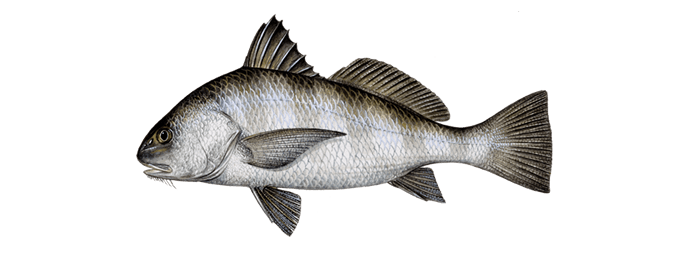Black Drum (Pogonias cromis)
A member of the Croaker family Black Drum can be a fun fish to catch in Miami. The Black drum is chunky with a high arched back and a flat belly. It has small pointed teeth in the front and large flat teeth closer to the throat that they use to crush the shell of crustaceans. The body colors of the Black Drum are a dark bronze color on the back that fades to a silvery color toward the bottom. The Fins are usually a very dark brown almost black in color. Juveniles have black verticle bars that start to fade as they grow into adulthood. They are closely related to the red drum or redfish as some may call them. A way to easily distinguish the Black Drum from the Redfish is by the barbells that are found under the mouth of the Black Drum. They can reach sizes of up to 5 feet long and weigh over 100 pounds. The average size Black drum you will catch in Miami is between 5 and 25 pounds. The largest Black drum ever caught in Florida was 128 inches and weighed 93 pounds. They are great eating fish similar to red snapper. They have a have white meat that has a firm moist flesh, large flakes, mildly sweet flavor. Some of the other names for the Black drum are Sea Drum, Drumfish, Drummer, Gray Drum, Banded Drum, Oyster Drum, Oyster Cracker, Pompey Drum, Striped Drum, and Puppy Drum. They get their name from the drumming sound these fish produce when you take them out of the water.

How to catch Black Drum in Miami
When fishing for black drum you can use mono or braid tied to a fluorocarbon leader with a circle hook. Using a half or quarter blue crab with the claws and legs removed will make it easier to catch this large beast. When fishing for Black Drum make sure not to have your drag too tight as they can pull pretty hard when they strike. When the Black Drum is hooked it is best to let them keep swimming until they hook themselves. Using traditional methods of setting the hook will almost always cause the bait to be pulled out of their mouth. The key to fishing for Black Drum is patience. You need to leave the bait in the water long enough that it gives them time to follow the scent and find your bait. If you see them but they are not grabbing your bait you should remove the shell of the crab and cut it into smaller pieces. If you catch one on or near a pier or bridge you need to be very careful that they don’t run into a piling and cut your line with the edges. If your targeting the larger Drums then using a whole crab is recommended because a big bait usually equals a big fish.
Where to fish for Black Drum
The best place to fish for black drum is around piers and bridges. Black Drum can also be found in the surf, estuaries, overpasses, near mangroves shell bars, and deep channels. The larger fish can be found more frequently near deeper water around structures with lots of currents. Finding deep channels near bridges is a favorite hiding spot of these fish. Throwing your bait far against the current and letting your bait drift into the target zone is a great strategy for hooking a Black Drum. Once the bait gets to the desired location you should leave your line in the water till you get a hit. You want to target a depth of anywhere between 10 and 45 feet. Be careful when fishing around structures as the Black Drum are cleaver fish that will try to tangle your line around pilings. During colder months the larger ones start to come closer to shore. The best place to find them in the shallow is in the clear water of sand flats. If your fishing in the surf, find a deep area between 2 sandbars is a great place to throw your bait.
Best time of the year for Miami Black Drum fishing
Black drum can be found in very shallow water inside of sandy flats through the spring and fall, and sometimes can also be found in the early summer mornings before the water gets too hot. During midday summer and winter season they are found in deeper waters around channels and under bridges. If your specifically targeting Black Drum then you should speak with a fishing Charter captain so they can give you more information on when they are biting in the Atlantic waters. Ideally, you want to find a backcountry fishing charter because they are usually found in shallow water.
The best bait to catch Black Drum
The best bait to catch Black drum is blue crabs but they will also eat other crustaceans such as shrimp, maritime worms, oysters, clams, mollusks, and occasionally small fish. The best bait for Black Drum is Blue crab that has be declawed and cut in half. You can also use frozen bait such as shrimp, blue crabs, or clams. When using shrimp you should remove the tail and if you’re using blue crab you should remove the claws and top shell and cut them in half or 1/4 size depending on the size of the fish your targeting. Because Black drum relies primarily on scent to find fish you should use natural bait that has a strong smell. The Black drum fish is rarely caught using jigs or lures because they rely primarily on scent. If the Black drums are not taking your bait you can squeeze the bait a little to release some of the scents and throw the bait back in.
Florida Black Drum fishing regulations
The minimum size limit for Black drum in Florida is 14 inches and the maximum size is 24 inches. You are also allowed to keep one fish that is over 24 inches. The bag limit for Florida Black drum is 5 per person. They can be fished using, hook and line, spear, gig, cast net, and seine. It is illegal to catch them using multiple hooks on your line with live or even dead bait. Snatching is also prohibited. A current Florida saltwater fishing license is required to fish for all types of saltwater species in Florida. You can obtain a license from the Florida Fish and Wildlife Conservation Commission by going online, calling or going to a bait and tackle shop. Florida residents who are fishing from shore, bridges or piers can get a recreational saltwater shoreline fishing license, which is free of charge.












